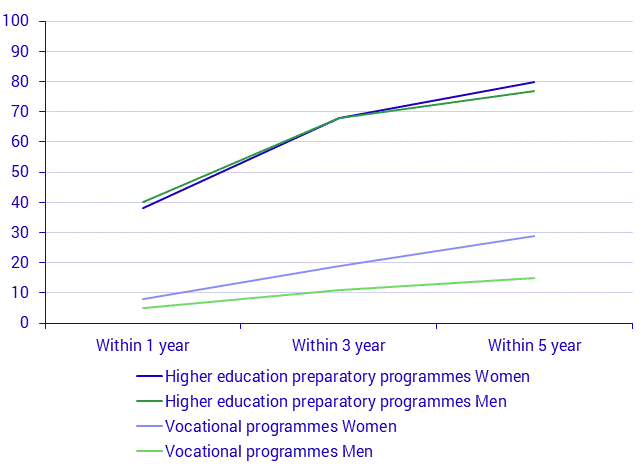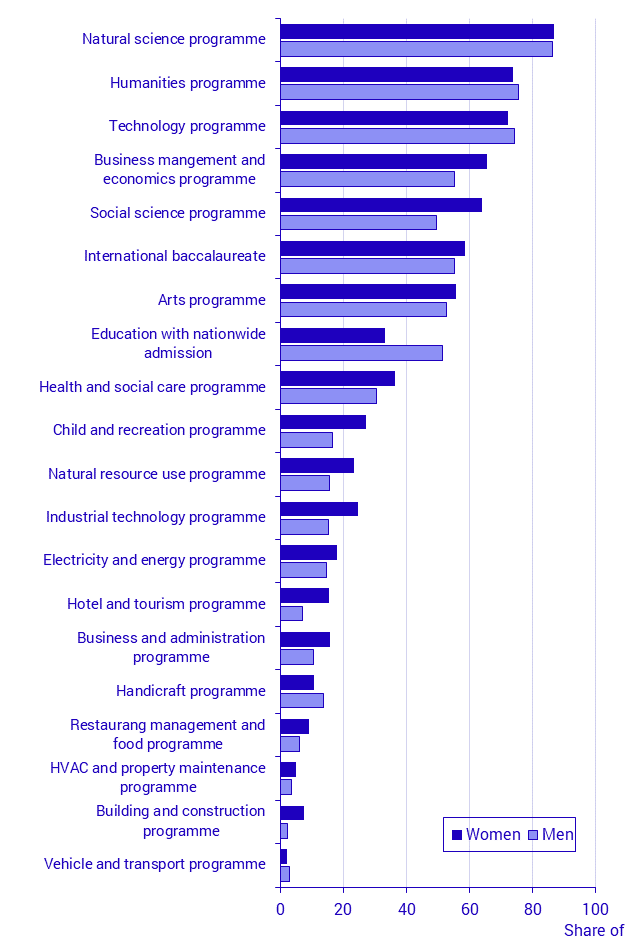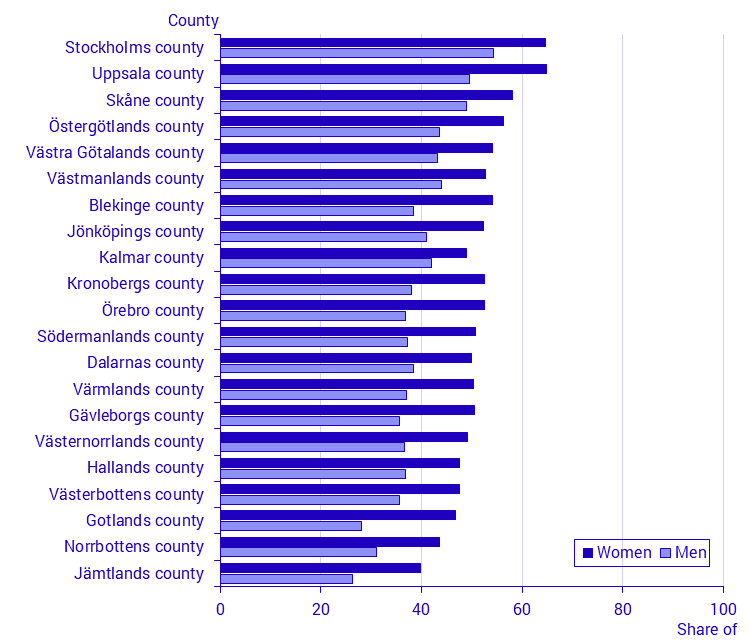Transition upper secondary school – post-secondary education, upper secondary school graduates 2013/14-2017/18
Fewer men who graduate from higher education preparatory programmes continue studying after upper secondary school
Statistical news from Statistics Sweden 2020-05-14 9.30
The share of men who graduate from higher education preparatory programmes who commence studying within the first year after graduation has dropped slightly, and among graduates in 2017/18 is on a level with the share of women (35 percent for men and 34 percent for women).
l news describes the transition from upper secondary school to post-secondary education. Post-secondary education includes university education and upper vocational education, as well as special courses at folk high schools and arts and cultural programmes.
Among upper secondary school graduates in 2017/18, 25 percent entered post-secondary education within an academic year, although the share was higher among graduates from higher education preparatory programmes (35 percent) than among graduates from vocational programmes. Among graduates from vocational programmes, there were major differences between women and men: it was much more common among women (9 percent) than among men (4 percent) to continue studying.
A five-year perspective means going back and studying the first graduates from the reformed upper secondary school Gy2011. The share of upper secondary school graduates in 2013/14 who commenced post-secondary studies within five academic years was 59 percent. This share was 65 percent for women and 52 percent for men. The difference between men and women is mainly due to the fact that, among those who graduated from vocational programmes, a larger share of women than men continued studying.

By far most common to study at university
After three academic years, many graduates have commenced post-secondary studies. To examine differences between programmes and regional differences, we study the share of those who commence studies within three years in more detail.
Among persons who graduated from upper secondary school in the academic year 2015/16, half of them commenced post-secondary studies within three academic years. This share was 56 percent for women and 44 percent for men. By far the largest share of those who commenced post-secondary school studies within three academic years attend university. Among graduates in 2015/16, 46 percent had commenced a higher education programme, 3 percent had attended a special course at a folk high school, 1 percent had commenced arts or cultural programmes and 3 percent had commenced higher vocational education studies within three academic years. In general, persons who commenced studies at higher vocational education were slightly older than in other forms of education, which in part explains the lower share of persons who transitioned.
Highest share of those who continue studying among graduates from the natural sciences programme
Among persons who transitioned to post-secondary education, there is a large difference in shares between those who attended higher education preparatory programmes and vocational upper secondary school programmes. Among graduates in 2015/16 who transitioned to post-secondary education within three years, 67 percent attended higher education preparatory programmes and 14 percent attended vocational programmes.
Among graduates in 2015/16 from higher education preparatory programmes, those attending the natural sciences programme accounted for the highest share of persons who commenced post-secondary school education within three academic years. The smallest share of persons who transitioned to higher education was among those attending arts programmes. Differences between women and men were generally minor. Although, the share of women who continued their studies was clearly larger among graduates from economics programmes and social science programmes.
Students from education with nationwide admission, including fields such as aircraft engineering and marine engineering, accounted for the largest share of graduates in 2015/16 from vocational programmes who commenced post-secondary school studies within three academic years, at 50 percent. The smallest share of students who transitioned to higher education were graduates from the building and construction programme, the vehicle and transport programme and the HVAC and property maintenance programme. The share of graduates who continued studying was larger among women than among men for all programmes except national programmes, the handicraft programme and the vehicle and transport prog

Overall, there is a low share of graduates who commenced studies at higher vocational education, special courses at folk high school, or arts or cultural programmes within three years after completing upper secondary school. The large majority of those who continue studying enroll in university. However, a few programmes stand out:
- Among graduates from the arts programme, 39 percent continued studies in higher education. It was also very common to continue studying at a folk high school (17 percent) or in an arts and cultural programme (5 percent). Around 4 percent studied in higher vocational education.
- Many graduates from the humanities programme also continued studying at a folk high school (8 percent).
- Graduates from the electricity and energy programme to a large extent continued studying in higher vocational education; nine percent attended higher vocational education within three years of graduating from upper secondary school.
- Around half of the graduates from education with nationwide admission who continued studying did so at university and around half continued studying at higher vocational education.
Jämtland County accounts for lowest share of graduates who continued studying
There are major differences between regions in shares of graduates who transitioned to post-secondary school studies. Among graduates in 2015/16 from upper secondary school, persons living in Stockholm County accounted for the largest share of those who transitioned to post-secondary education within three years, at 60 percent. The smallest share in the same time period was among those living in Jämtland County, at 33 percent. In general, the share of graduates who transitioned to further studies is higher in metropolitan regions and regions with major colleges or universities.
The average share of those who commenced studies at higher vocational education was 3 percent. This percentage was slightly higher, 4 percent, in Östergötland County and Dalarna County. The share of those who studied at folk high school was also 3 percent on average, although slightly more, 6 percent, among upper secondary school graduates in Kronoberg County, and 5 percent among graduates in the counties of Östergötland, Jönköping and Gotland.

Definitions and explanations
The following forms of post-secondary education are included in this statistic:
- Higher education. In the calendar year 2019, 89 800 persons enrolled in university for the first time, and 465 200 persons in total were enrolled in at least one course. More statistics are available on www.scb.se/UF0205. Read more about higher education on www.uka.se.
- Higher vocational education. In the calendar year 2019, 281 000 admitted students commenced their studies and 63 200 persons studied in higher vocational education. Further statistics are available on www.scb.se/UF0701. Read more about higher vocational education on www.myh.se.
- Folk high school special course. In the calendar year 2019, there were 48 400 participants in special courses. More statistics are available on www.scb.se/UF0601. Read more about this form of education on www.folkbildningsradet.se.
- Arts and cultural programmes, and certain other programmes. The most recent data available refers to 2018. There were 3 400 students admitted who commenced their studies and 6 400 attended studies during the year. Further statistics are available on www.scb.se/UF0702. Read more about this form of education on www.myh.se.
Next publishing will be
2021
Statistical Database
More information is available in the Statistical Database
Feel free to use the facts from this statistical news but remember to state Source: Statistics Sweden.
